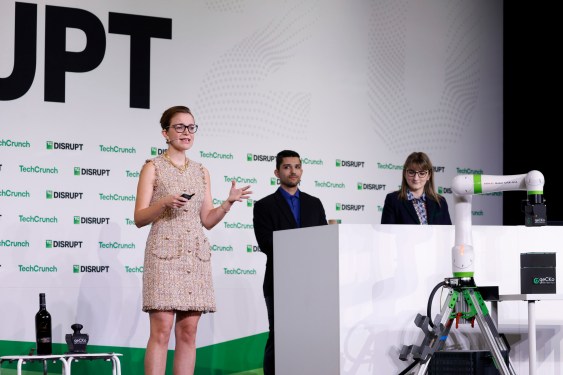Gecko Materials, the 2024 runner-up in the TechCrunch Disrupt Startup Battlefield, returned to the stage at this year’s show to debut new products. The company is pushing deeper into commercializing its technology. Founder Dr. Capella Kerst revealed four new uses of Gecko’s super-strong dry adhesive. These include a semiconductor wafer handling tool, a robotic gripper for smooth surfaces like solar panels or glass, a curved robotic end effector for more irregular shapes, and an all-purpose gripper for robotic arms.
The Gecko technology is inspired by the way real-life lizards use their feet to grip surfaces. Kerst positions it as a new form of Velcro, but one that leaves no residue, can quickly attach and detach, and requires no electrical charge or suction. A one-inch tile of the material can hold 16 pounds. The Gecko dry adhesive can attach as many as 120,000 times and can stay attached for seconds, minutes, or years.
The ability to quickly adapt the dry adhesive to existing manufacturing, picking, and other robotic applications has proven popular. Kerst’s company won over Ford, NASA, and Pacific Gas & Electric as customers before she even competed on last year’s Battlefield stage.
On the TechCrunch Disrupt stage, Kerst remarked on how quickly the year has passed. The Gecko CEO said her company has tripled the size of her team since last year’s show and completed an eight million dollar fundraise. Gecko’s dry adhesive was used on six space missions in the last year, a testament to the material’s ability to work in multiple environments, including a vacuum.
Onstage, Kerst showed off a Fanuc robotic arm using six Gecko tiles to quickly grab and move objects around. She also showed videos of other commercialized applications. In one video, Kerst showed Gecko’s material being used to safely move semiconductor wafers faster than current suction or vacuum tech allows. She stated that customers at TSMC, Samsung, Intel, and Kawasaki had a goal to move the wafers at 2Gs of acceleration. Kerst said the company decided to blow them out of the water and achieve 5.4Gs of acceleration repeatedly and reliably using Gecko materials.

